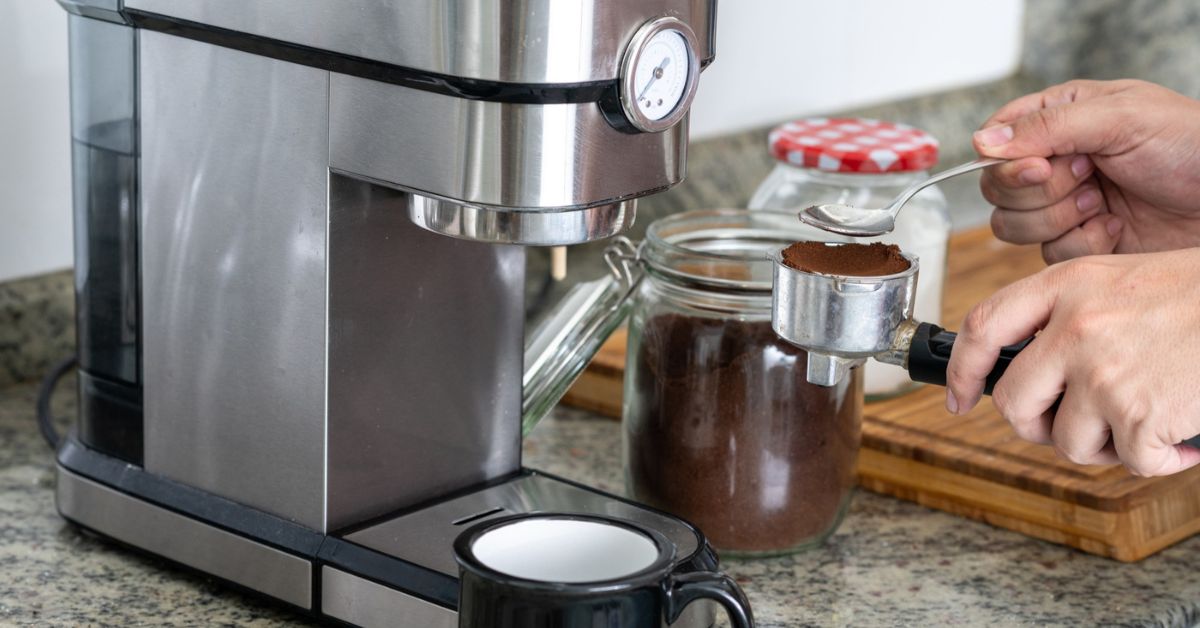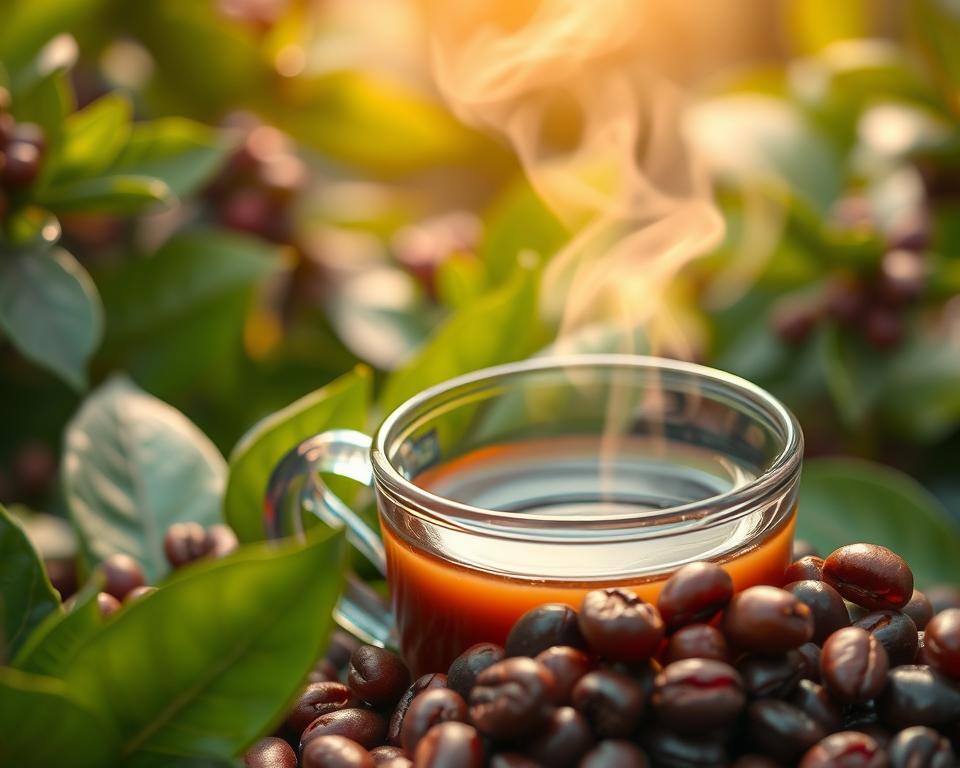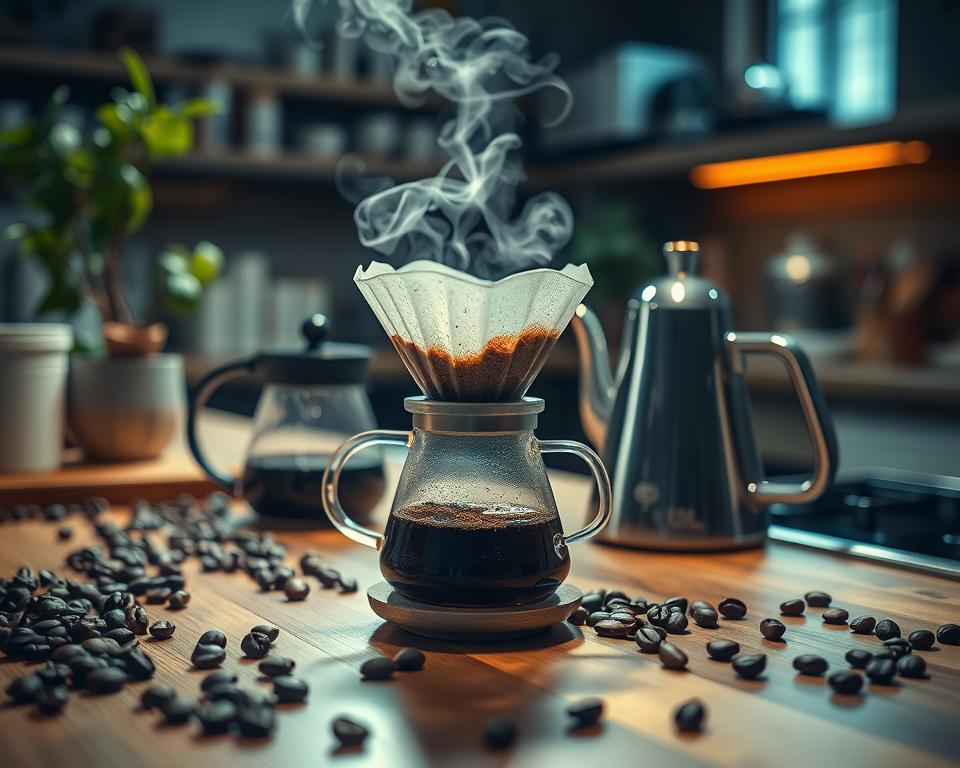Imagine a coffee so rare that even enthusiasts rarely taste it—that’s Liberica. This bean stands out in a world where Arabica and Robusta rule. It has large, oddly shaped beans that bring something new to the table. When I explore the coffee flavour profiles, I find Liberica’s taste unique and intriguing. It has a fruity sweetness with hints of flowers. This has made me very curious about the different flavours coffee can have.
I love how blends of Arabica and Liberica mix smoothness with something special. These combinations create tastes that go beyond the usual. Even Robusta’s strong bitterness blends well here, softened by Liberica’s sweet side.
For someone like me who loves coffee, learning about these flavours is like taking a world tour with just a cup. It takes me from the bright acidity of Ethiopia to Kenya’s rich flavours.
My taste adventure also goes through Tanzania’s Mount Kilimanjaro to Rwanda’s highlands. Each local bean shares its own story of where it comes from. I’ve learned that enjoying coffee is more than just making it.
It’s about understanding the culture, climate, and community behind each kind of bean.
Coffee Flavour Profiles: Key Takeaways
- Liberica coffee offers a distinct addition to diverse coffee flavour profiles.
- The rarity of Liberica is an invitation to explore nuanced coffee tasting notes.
- Blends featuring Liberica coffee contribute to a broader sensory experience.
- Global coffee regions deliver unique specialty coffee flavours to savour and study.
- Understanding the subtleties of different coffee flavours enriches the drinking experience.
- Appreciating the connection between regional characteristics and flavours deepens one’s coffee expertise.
The Sensory Journey of Coffee Flavour Profiles
As a true coffee lover, I dived into the world of coffee flavour profiles. This journey has boosted my appreciation for the coffee flavour wheel. It’s a tool that shows the complex flavours in each cup.
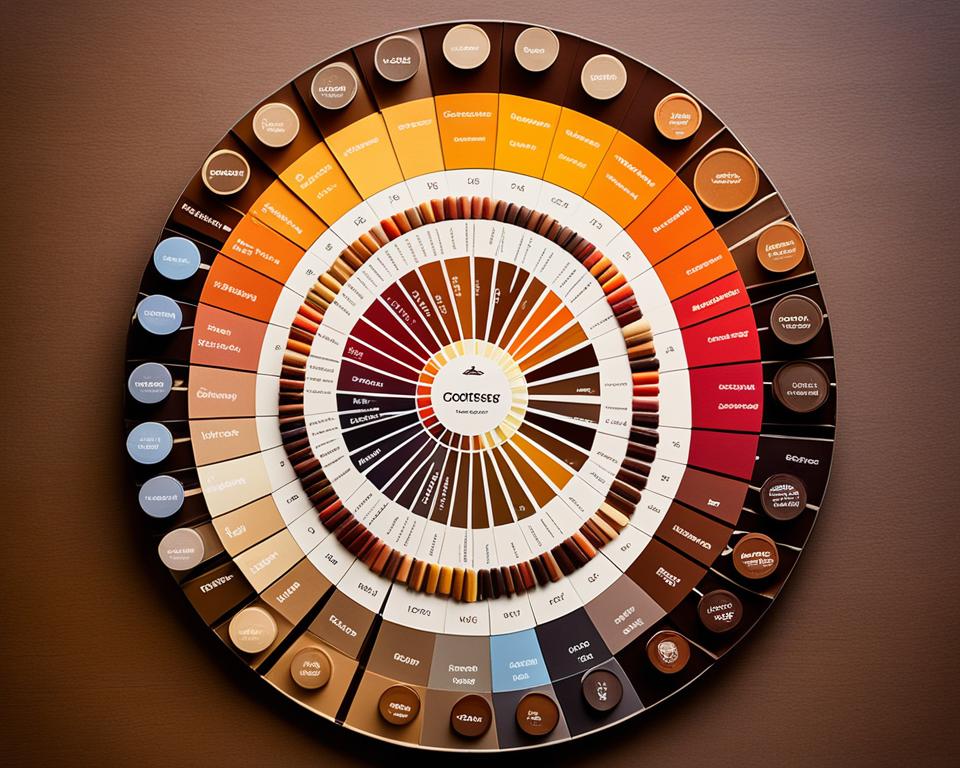
I explored the aromatic world of coffee. Each sip reflects the soil and climate where its beans grew. A major study involving over 70 tasters showed we can identify coffee bean aromas together.
Starting with a Sip: Understanding Taste Nuances
Experts from Kansas State University helped me learn about different types of coffee flavors. Their work helps us understand coffee’s varied flavors. These range from subtle nuttiness to the strength of dark roast.
From Beans to Brew: How Processing Affects Flavour
Processing methods add another layer to coffee’s taste. The choice between a natural or washed process affects the coffee’s flavor. These choices can enhance a coffee’s fruitiness or its crisp, bright acidity.
The Role of Origin: Regional Flavour Identities
I can now recognise unique coffee flavour wheel identities from different places. Research by the University of California, Davis, played a big part in this.
They showed how factors like origin affect the flavours we taste, making each coffee’s background a taste adventure.
The blending of knowledge from fields like food science and psychology deepens our taste understanding. Although tasting is personal, shaped by our culture and memories, initiatives by the Specialty Coffee Association of America have given us a way to share our coffee experiences.
They introduced the Coffee Taster’s Flavour Wheel, giving us a common language to talk about coffee’s rich flavours.
Unveiling the Coffee Flavour Profiles: A Barista’s Secret Weapon
The scent of coffee is just the start of a deep flavour journey. Every skilled barista understands that the coffee flavour profile is key. It helps pinpoint and share the specific tastes of coffee, from earthy Indonesian beans to fruity Ethiopian ones.
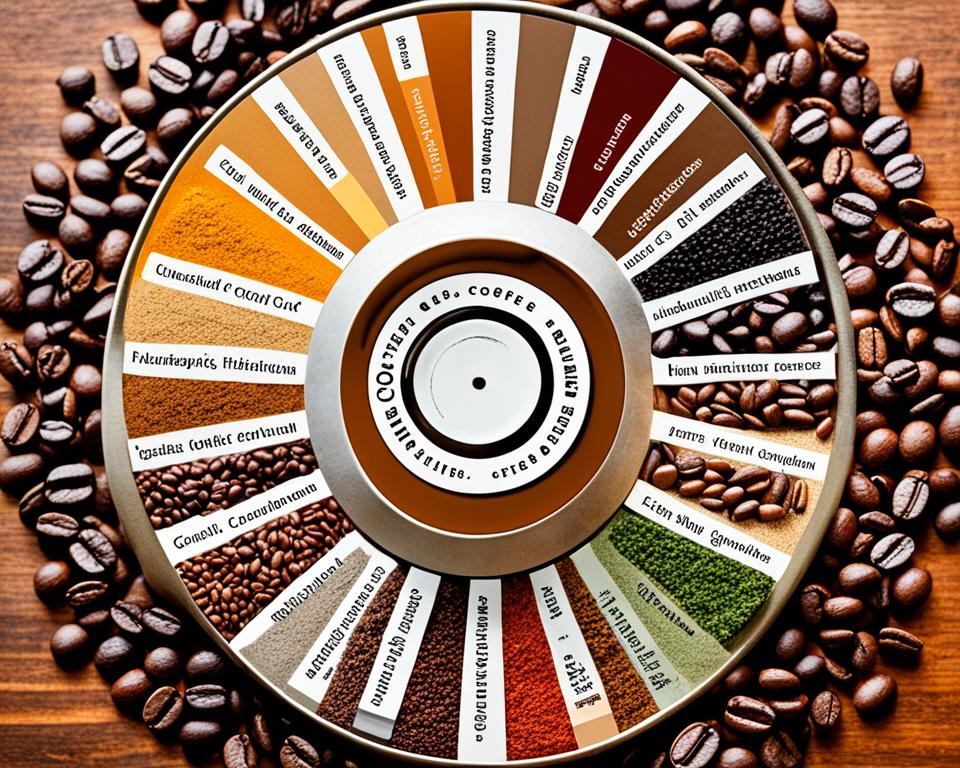
Yet, climate change threatens our coffee world, pressing a need to talk about its effects. Studies show a potential 54% drop in coffee farming land by 2100, even with climate efforts.
This huge change would affect the variety of coffee flavors we love.
“The rich tapestry of flavors we currently enjoy is under threat, as climate change could drastically alter the very essence of the coffee we’ve come to know,” David Taylor from the Fairtrade Foundation articulates, highlighting the plight of smallholder farmers against the climate crisis.
Brazil and Vietnam, major coffee sources for the U.K., face climate risks that could change flavor profiles. High temperatures, like Vietnam’s record 44.1 degrees Celsius, underline the urgency.
Ethiopia’s coffee industry, which is crucial to its culture and economy, also faces risks from climate change.
| Country | Percentage of U.K. Coffee Imports | Recorded Temperature: Extreme | Impact on Coffee Industry |
|---|---|---|---|
| Brazil | Part of >50% | N/A | Climate Vulnerability |
| Vietnam | Part of >50% | 44.1 °C | Climate Vulnerability |
| Ethiopia | Significant | N/A | Industry under Threat |
Fairtrade fights for coffee farmers facing ‘catastrophic’ climate impacts. Despite Arabs’ low emissions, they suffer greatly. This sparks a vital conversation about coffee and sustainability.
I believe in showing the joy in each coffee bean and the need to protect our coffee future. Imagining a world with less coffee depth is sad for enthusiasts.
Tasting coffee means we must support sustainability for lasting coffee diversity.
Costa Rican Delights: Diving Into Coffee Bean Aromas
I explore Costa Rica’s coffee scene, finding stories in the highlands. Over 70% of the coffee grows from 1,200 to 1,800 metres high. These heights give the beans complex and rich flavours.
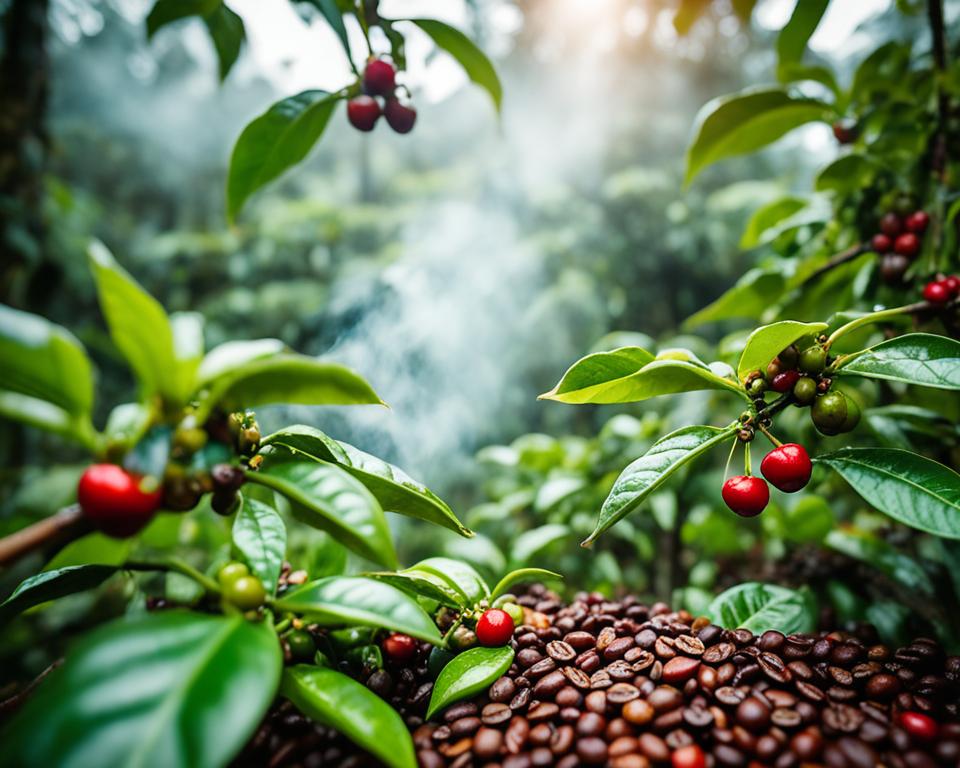
Costa Rica’s coffee smells come from its volcanic soil. This gives specialty coffee flavours a peek into nature’s kills. The land’s 21% protected areas help farm coffee sustainably.
This approach results in a truthful, earthy taste with each harvest.
Volcanic Soil and Aromatic Influences
The link between volcanic soil and aroma is strong. I learn how soil minerals fill the coffee flavour wheel with various notes. It’s like nature painting with deep, earthy strokes.
Regional Varietals and Their Signature Scents
Regions like Tarrazú and the Central Valley add different scents. I smell acid from Tarrazú and the bright essence of Central Valley’s coffee.
Varietals like Caturra, Catuai, Typica, and Villa Sarchi add unique smells. The coffee artisans here skillfully roast the beans to highlight their true scents and flavours.
Costa Rica enchants me, from careful bean picking to its Cup of Excellence. The dedication to crafting coffee shows a strong connection between the soil, the artisan, and my cup.
This bond is celebrated with every sip of Costa Rican coffee.
How Does Dark Roast Coffee Compare to Other Coffee Flavor Profiles?
Dark roast flavor exploration reveals a bold and rich taste that can overshadow the subtler notes found in lighter roasts. While lighter coffees often showcase floral and fruity nuances, dark roasts deliver a robust, smoky profile with a hint of sweetness, appealing to those who prefer a more intense coffee experience.
Discovering Coffee Flavour Profiles Through Roasting
Roasting coffee shapes the essence of each bean, unveiling a variety of flavors. Light roasts result in a thin, delicate texture that allows subtle tastes to shine. Dark roasts, on the other hand, offer a creamy and rich experience. Every roasting stage reveals new flavour elements, from bright acidity to deep cocoa notes.
The global coffee market is booming, reaching USD 15.1 billion. Coffee lovers are also drawn to its health benefits. These include lower risks of type 2 diabetes and heart disease.
Enjoying coffee might not just taste good but could also be good for your health. I explore the perfect roast considering these aspects, linking taste with well-being.
Expert tasters, including those at Starbucks®, use a vocabulary of 59 sensory attributes. Our sense of smell helps us identify unique aromas, like toasted nuts or spice.
In roasting, I aim to enhance these desirable flavours without adding unwanted ones. This way, I’m not just selling a drink but a carefully crafted experience.
FAQ
What can I expect from the coffee flavour profiles?
Coffee flavours vary widely, from rich and chocolaty to light and floral. Specialty coffee showcases unique, subtle tastes. These are from careful growing and processing. There’s always something new to try, no matter your experience level.
How does the coffee flavour wheel enhance my tasting experience?
The coffee flavour wheel is a guide to understanding coffee’s complex tastes. It helps describe the differences in flavour, like earthy or fruity notes. This tool deepens my knowledge and joy of coffee flavours.
In what ways does the bean processing method affect coffee flavours?
Processing methods, natural or washed, change a coffee’s taste. Natural processing brings out sweetness and fruity qualities. Washed beans give a cleaner taste with a brighter acidity. Knowing this lets me guess the flavours of coffee beans.
How does a coffee’s origin influence its flavour profile?
Each coffee-growing area’s unique environment affects the beans’ taste. For instance, Costa Rican coffee is bright and full because of its soil and farming. Exploring beans from various places shows me how origin impacts flavour.
Why is Costa Rican coffee often considered a top choice for coffee connoisseurs?
Costa Rican coffee is prized for its quality, thanks to strict production rules and great soil. It has a balanced flavour with lively acidity and rich aromas. Costa Rican coffee stands out as a specialty coffee favourite.
What impact does roasting have on coffee flavour development?
Roasting transforms green beans, bringing out flavours from light to dark roasts. Light roasts keep the original taste, like acidity. Dark roasts focus on deeper notes, like chocolate. Good roasting enhances the beans, making the coffee better.
Can the same type of coffee bean taste different based on roasting and preparation?
Yes! The same coffee bean can taste very different with changes in roast and brew. Roasting affects the bean’s flavour, and brewing adjusts the taste too. Experimenting with these can uncover a bean’s full flavour potential.


